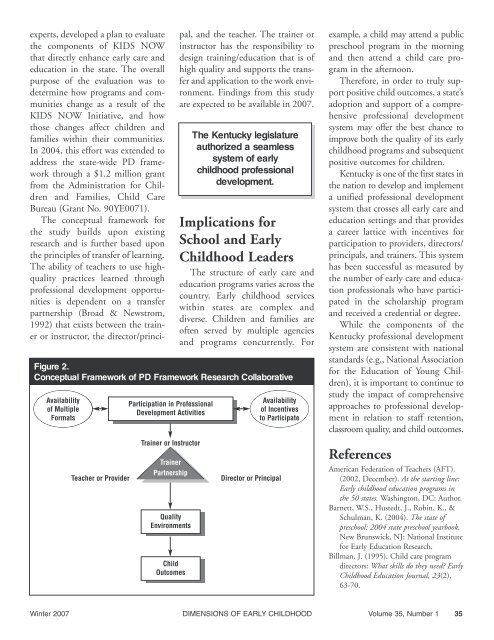Dimensions of Early Childhood - Southern Early Childhood ...
Dimensions of Early Childhood - Southern Early Childhood ...
Dimensions of Early Childhood - Southern Early Childhood ...
You also want an ePaper? Increase the reach of your titles
YUMPU automatically turns print PDFs into web optimized ePapers that Google loves.
experts, developed a plan to evaluate<br />
the components <strong>of</strong> KIDS NOW<br />
that directly enhance early care and<br />
education in the state. The overall<br />
purpose <strong>of</strong> the evaluation was to<br />
determine how programs and communities<br />
change as a result <strong>of</strong> the<br />
KIDS NOW Initiative, and how<br />
those changes affect children and<br />
families within their communities.<br />
In 2004, this effort was extended to<br />
address the state-wide PD framework<br />
through a $1.2 million grant<br />
from the Administration for Children<br />
and Families, Child Care<br />
Bureau (Grant No. 90YE0071).<br />
The conceptual framework for<br />
the study builds upon existing<br />
research and is further based upon<br />
the principles <strong>of</strong> transfer <strong>of</strong> learning.<br />
The ability <strong>of</strong> teachers to use highquality<br />
practices learned through<br />
pr<strong>of</strong>essional development opportunities<br />
is dependent on a transfer<br />
partnership (Broad & Newstrom,<br />
1992) that exists between the trainer<br />
or instructor, the director/principal,<br />
and the teacher. The trainer or<br />
instructor has the responsibility to<br />
design training/education that is <strong>of</strong><br />
high quality and supports the transfer<br />
and application to the work environment.<br />
Findings from this study<br />
are expected to be available in 2007.<br />
The Kentucky legislature<br />
authorized a seamless<br />
system <strong>of</strong> early<br />
childhood pr<strong>of</strong>essional<br />
development.<br />
Implications for<br />
School and <strong>Early</strong><br />
<strong>Childhood</strong> Leaders<br />
The structure <strong>of</strong> early care and<br />
education programs varies across the<br />
country. <strong>Early</strong> childhood services<br />
within states are complex and<br />
diverse. Children and families are<br />
<strong>of</strong>ten served by multiple agencies<br />
and programs concurrently. For<br />
Figure 2.<br />
Conceptual Framework <strong>of</strong> PD Framework Research Collaborative<br />
Availability<br />
<strong>of</strong> Multiple<br />
Formats<br />
Teacher or Provider<br />
Participation in Pr<strong>of</strong>essional<br />
Development Activities<br />
Trainer or Instructor<br />
Trainer<br />
Partnership<br />
Quality<br />
Environments<br />
Child<br />
Outcomes<br />
Availability<br />
<strong>of</strong> Incentives<br />
to Participate<br />
Director or Principal<br />
example, a child may attend a public<br />
preschool program in the morning<br />
and then attend a child care program<br />
in the afternoon.<br />
Therefore, in order to truly support<br />
positive child outcomes, a state’s<br />
adoption and support <strong>of</strong> a comprehensive<br />
pr<strong>of</strong>essional development<br />
system may <strong>of</strong>fer the best chance to<br />
improve both the quality <strong>of</strong> its early<br />
childhood programs and subsequent<br />
positive outcomes for children.<br />
Kentucky is one <strong>of</strong> the first states in<br />
the nation to develop and implement<br />
a unified pr<strong>of</strong>essional development<br />
system that crosses all early care and<br />
education settings and that provides<br />
a career lattice with incentives for<br />
participation to providers, directors/<br />
principals, and trainers. This system<br />
has been successful as measured by<br />
the number <strong>of</strong> early care and education<br />
pr<strong>of</strong>essionals who have participated<br />
in the scholarship program<br />
and received a credential or degree.<br />
While the components <strong>of</strong> the<br />
Kentucky pr<strong>of</strong>essional development<br />
system are consistent with national<br />
standards (e.g., National Association<br />
for the Education <strong>of</strong> Young Children),<br />
it is important to continue to<br />
study the impact <strong>of</strong> comprehensive<br />
approaches to pr<strong>of</strong>essional development<br />
in relation to staff retention,<br />
classroom quality, and child outcomes.<br />
References<br />
American Federation <strong>of</strong> Teachers (AFT).<br />
(2002, December). At the starting line:<br />
<strong>Early</strong> childhood education programs in<br />
the 50 states. Washington, DC: Author.<br />
Barnett, W.S., Hustedt, J., Robin, K., &<br />
Schulman, K. (2004). The state <strong>of</strong><br />
preschool: 2004 state preschool yearbook.<br />
New Brunswick, NJ: National Institute<br />
for <strong>Early</strong> Education Research.<br />
Billman, J. (1995). Child care program<br />
directors: What skills do they need? <strong>Early</strong><br />
<strong>Childhood</strong> Education Journal, 23(2),<br />
63-70.<br />
Winter 2007 DIMENSIONS OF EARLY CHILDHOOD Volume 35, Number 1 35

















